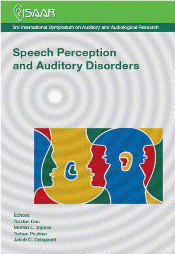Speech intelligibility as a function of time compression, age, word position, and signal-to-noise ratio
Abstract
Among other parameters, speech intelligibility depends on the rate of speech. Therefore, variation of time compression might be useful for adjusting the threshold of 50% intelligibility in speech in noise tests at fixed positive signal-to-noise ratios (SNRs). Speech rate can be modified with uniform and non-uniform algorithms. Uniform algorithms delete equally spaced segments, while non-uniform algorithms first characterize the structure of the speech and then increase the speech rate dependent on the classification. Referring to studies using fast speech, age effects have to be taken into account. To investigate fast speech in a German speech intelligibility test, sentences speeded to different time compressions were presented at different SNRs and intelligibility measurements were conducted with young and elderly normal-hearing listeners. The outcomes were used to calculate SNR-dependent discrimination functions. The results showed increasing SNRs for 50% intelligibility with increasing time compression. As expected, young listeners reached higher intelligibility than elderly listeners at equal time compressions and SNRs for 50% intelligibility were shifted to lower values. Additionally, increasing the speech rate affected word intelligibility in dependence on the words’ position within the sentences. These differences in intelligibility led to shallower slopes of the discrimination functions and could possibly constrain the accuracy of the test.
References
Boetsma, P. and Weenink, D. (2009). “Praat – doing phonetics by computer (version 5.1.15)” www.praat.org (last viewed 08/02/2011).
Covell, M., Withgott, M. and Slaney, M. (1998). “Mach1: Nonuniform Time-Scale Modificaton of Speech” in Proceedings of the 1998 IEEE International Conference on Acoustics, Speech, and Signalprocessing, Seattle, 1, 349-352.
Gordon-Salant, S. and Fitzgibbons, P. J. (2001). “Sources of Age-Related Recognition Difficulty for Time-Compressed Speech” J. Speech, Lang., and Hear. Res., 44, 709-719.
Gordon-Salant, S. and Fitzgibbons, P. J. (2004). “Effects of stimulus and noise rate variability on speech perception by younger and older adults” J. Acoust. Soc. Am., 115, 1808-1817.
Gordon-Salant, S. and Friedman, S. A. (2011). “Recognition of Rapid Speech by Blind and Sighted Older Adults” J. Speech, Lang., and Hear. Res, 54, 622-631.
Moulines, E. and Charpentier, F. (1990). “Pitch-synchronous waveform processing techniques for text-to-speech synthesis using diphones” Speech Comm., 9, 453– 467.
Nilsson, M., Soli S. D. and Sullivan, J. A. (1994). “Development of the Hearing In Noise Test for the measurement of speech reception thresholds in quiet and in noise” J. Acoust. Soc. Am., 95, 1085-1099.
Schlueter, A. (2007) “Perzeptive Beurteilung von Sprache im Störgeräusch”, Master’s thesis, Oldenburg University.
Schneider, B. A., Daneman, M. and Murphy, D. R. (2005). “Speech Comprehension Difficulties in Older Adults: Cognitive Slowing or Age-Related Changes in Hearing?” Psychology and Aging, 20, 261-271.
Tun, P. A. (1998). “Fast noisy speech: age differences in processing rapid speech with background noise” Psychology and Aging, 13, 424-434.
Versfeld, N. J and Dreschler, W. A. (2002). “The relationship between the intelligibility of time-compressed speech and speech in noise in young and elderly listeners” J. Acoust. Soc. Am., 111, 401-8.
Wagener, K. and Brand T. (2005). “Sentence intelligibility in noise for listeners with normal hearing and hearing impairment: Influence of measurement procedure and masking parameters” Int. J. Audiol., 44, 144-156.
Wagener, K., Kühnel, V. and Kollmeier, B. (1999). “Entwicklung und Evaluation eines Satztests für die deutsche Sprache I: Design des Oldenburger Satztests” Z. Audiol., 38, 4-15.
Additional Files
Published
How to Cite
Issue
Section
License
Authors who publish with this journal agree to the following terms:
a. Authors retain copyright* and grant the journal right of first publication with the work simultaneously licensed under a Creative Commons Attribution License that allows others to share the work with an acknowledgement of the work's authorship and initial publication in this journal.
b. Authors are able to enter into separate, additional contractual arrangements for the non-exclusive distribution of the journal's published version of the work (e.g., post it to an institutional repository or publish it in a book), with an acknowledgement of its initial publication in this journal.
c. Authors are permitted and encouraged to post their work online (e.g., in institutional repositories or on their website) prior to and during the submission process, as it can lead to productive exchanges, as well as earlier and greater citation of published work (See The Effect of Open Access).
*From the 2017 issue onward. The Danavox Jubilee Foundation owns the copyright of all articles published in the 1969-2015 issues. However, authors are still allowed to share the work with an acknowledgement of the work's authorship and initial publication in this journal.


